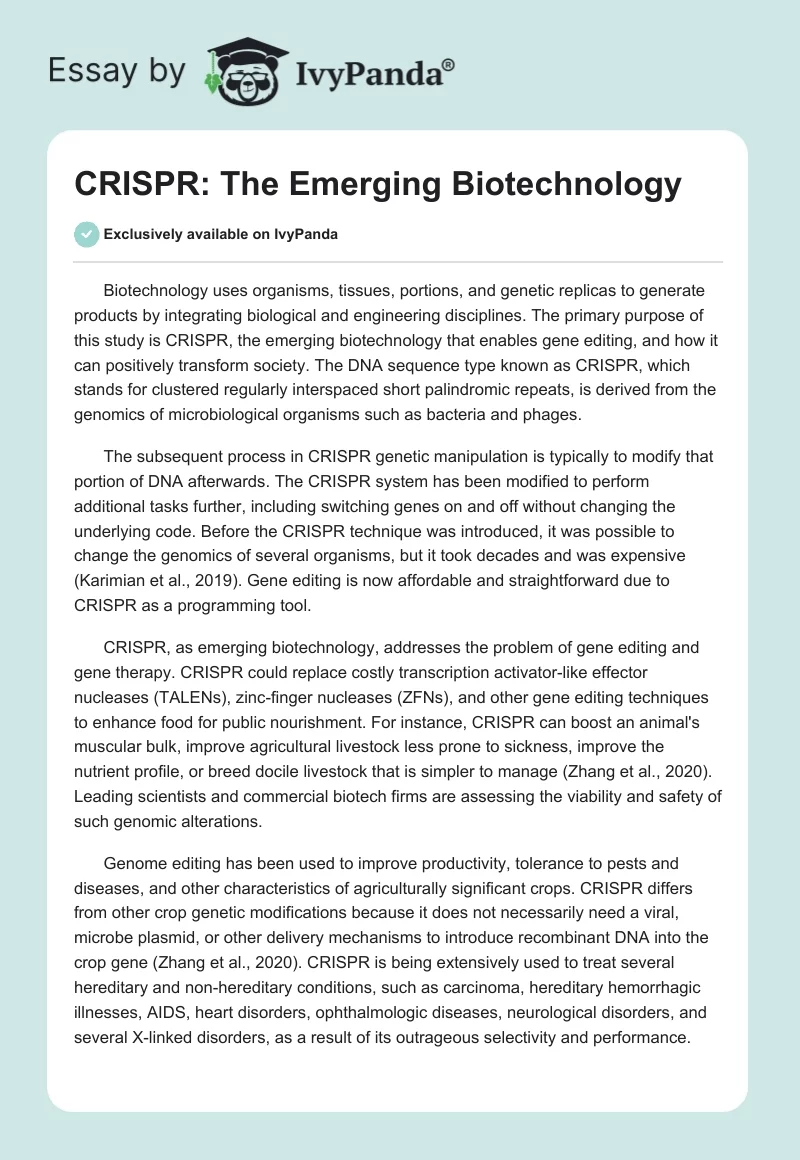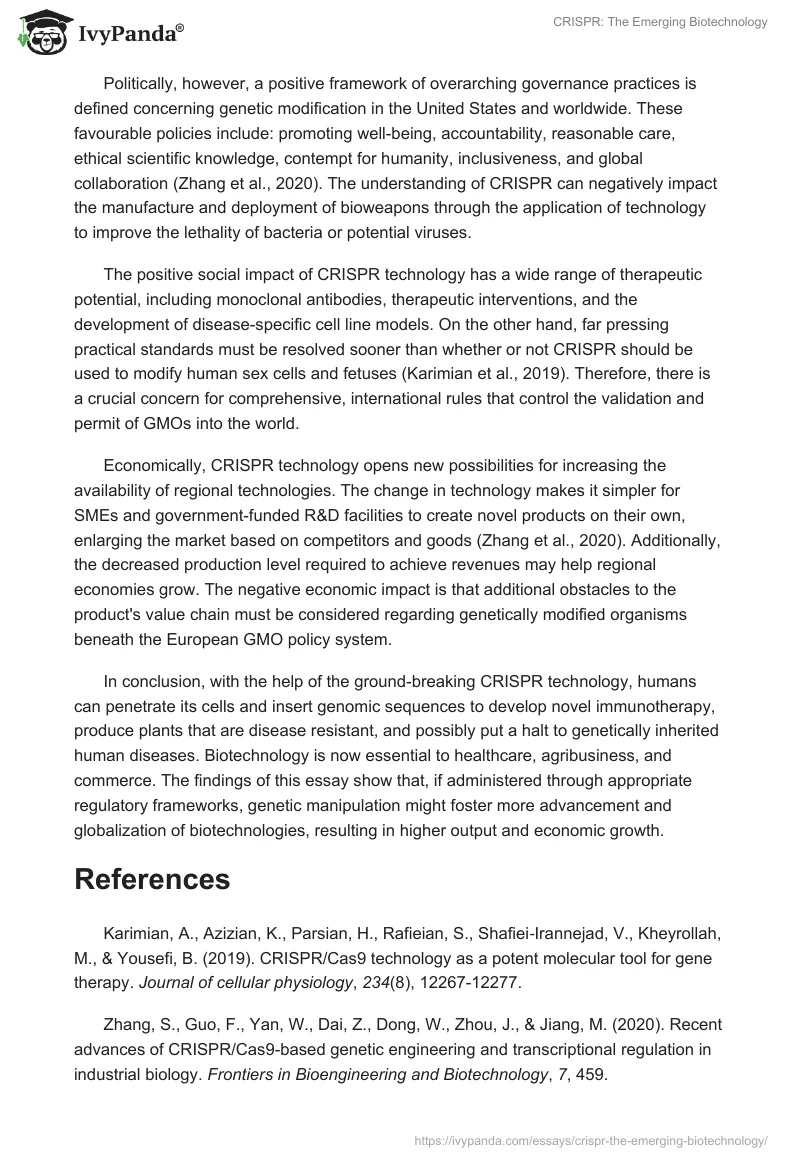Biotechnology uses organisms, tissues, portions, and genetic replicas to generate products by integrating biological and engineering disciplines. The primary purpose of this study is CRISPR, the emerging biotechnology that enables gene editing, and how it can positively transform society. The DNA sequence type known as CRISPR, which stands for clustered regularly interspaced short palindromic repeats, is derived from the genomics of microbiological organisms such as bacteria and phages.
The subsequent process in CRISPR genetic manipulation is typically to modify that portion of DNA afterwards. The CRISPR system has been modified to perform additional tasks further, including switching genes on and off without changing the underlying code. Before the CRISPR technique was introduced, it was possible to change the genomics of several organisms, but it took decades and was expensive (Karimian et al., 2019). Gene editing is now affordable and straightforward due to CRISPR as a programming tool.
CRISPR, as emerging biotechnology, addresses the problem of gene editing and gene therapy. CRISPR could replace costly transcription activator-like effector nucleases (TALENs), zinc-finger nucleases (ZFNs), and other gene editing techniques to enhance food for public nourishment. For instance, CRISPR can boost an animal’s muscular bulk, improve agricultural livestock less prone to sickness, improve the nutrient profile, or breed docile livestock that is simpler to manage (Zhang et al., 2020). Leading scientists and commercial biotech firms are assessing the viability and safety of such genomic alterations.
Genome editing has been used to improve productivity, tolerance to pests and diseases, and other characteristics of agriculturally significant crops. CRISPR differs from other crop genetic modifications because it does not necessarily need a viral, microbe plasmid, or other delivery mechanisms to introduce recombinant DNA into the crop gene (Zhang et al., 2020). CRISPR is being extensively used to treat several hereditary and non-hereditary conditions, such as carcinoma, hereditary hemorrhagic illnesses, AIDS, heart disorders, ophthalmologic diseases, neurological disorders, and several X-linked disorders, as a result of its outrageous selectivity and performance.
Politically, however, a positive framework of overarching governance practices is defined concerning genetic modification in the United States and worldwide. These favourable policies include: promoting well-being, accountability, reasonable care, ethical scientific knowledge, contempt for humanity, inclusiveness, and global collaboration (Zhang et al., 2020). The understanding of CRISPR can negatively impact the manufacture and deployment of bioweapons through the application of technology to improve the lethality of bacteria or potential viruses.
The positive social impact of CRISPR technology has a wide range of therapeutic potential, including monoclonal antibodies, therapeutic interventions, and the development of disease-specific cell line models. On the other hand, far pressing practical standards must be resolved sooner than whether or not CRISPR should be used to modify human sex cells and fetuses (Karimian et al., 2019). Therefore, there is a crucial concern for comprehensive, international rules that control the validation and permit of GMOs into the world.
Economically, CRISPR technology opens new possibilities for increasing the availability of regional technologies. The change in technology makes it simpler for SMEs and government-funded R&D facilities to create novel products on their own, enlarging the market based on competitors and goods (Zhang et al., 2020). Additionally, the decreased production level required to achieve revenues may help regional economies grow. The negative economic impact is that additional obstacles to the product’s value chain must be considered regarding genetically modified organisms beneath the European GMO policy system.
In conclusion, with the help of the ground-breaking CRISPR technology, humans can penetrate its cells and insert genomic sequences to develop novel immunotherapy, produce plants that are disease resistant, and possibly put a halt to genetically inherited human diseases. Biotechnology is now essential to healthcare, agribusiness, and commerce. The findings of this essay show that, if administered through appropriate regulatory frameworks, genetic manipulation might foster more advancement and globalization of biotechnologies, resulting in higher output and economic growth.
References
Karimian, A., Azizian, K., Parsian, H., Rafieian, S., Shafiei‐Irannejad, V., Kheyrollah, M., & Yousefi, B. (2019). CRISPR/Cas9 technology as a potent molecular tool for gene therapy. Journal of cellular physiology, 234(8), 12267-12277.
Zhang, S., Guo, F., Yan, W., Dai, Z., Dong, W., Zhou, J., & Jiang, M. (2020). Recent advances of CRISPR/Cas9-based genetic engineering and transcriptional regulation in industrial biology. Frontiers in Bioengineering and Biotechnology, 7, 459.


